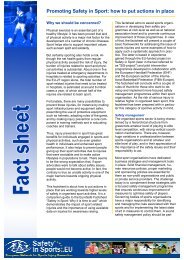Burden of Sport Injuries in the European Union - Safety in Sports
Burden of Sport Injuries in the European Union - Safety in Sports
Burden of Sport Injuries in the European Union - Safety in Sports
You also want an ePaper? Increase the reach of your titles
YUMPU automatically turns print PDFs into web optimized ePapers that Google loves.
37<br />
6 | February 2012<br />
differentiation <strong>in</strong> sections <strong>of</strong> <strong>in</strong>jury surveillance is not always clear-cut. There are<br />
many reasons for this rang<strong>in</strong>g from differences <strong>in</strong> <strong>the</strong> organization <strong>of</strong> <strong>the</strong> national<br />
health care systems to cultural differences <strong>in</strong> <strong>the</strong> report<strong>in</strong>g <strong>of</strong> <strong>in</strong>jury causes. The EU<br />
IDB is a selection <strong>of</strong> cases that come <strong>in</strong>to contact with <strong>the</strong> hospital accident and<br />
emergency department. As a result certa<strong>in</strong> data limitations and biases must be taken<br />
<strong>in</strong>to account when compar<strong>in</strong>g data sets; specifically differences <strong>in</strong> sampl<strong>in</strong>g, extrapolation<br />
methods and heath care consumption and hospitalisation practices across<br />
countries (accessibility, specialisation <strong>of</strong> <strong>the</strong> hospitals caus<strong>in</strong>g under- or overrepresentation<br />
<strong>of</strong> certa<strong>in</strong> <strong>in</strong>juries, etc.) (Bauer 2005).<br />
Country differences impacts <strong>the</strong> validity <strong>of</strong> <strong>the</strong> <strong>in</strong>jury <strong>in</strong>cidence calculated <strong>in</strong> each<br />
country. For example, because <strong>of</strong> <strong>the</strong> high share <strong>of</strong> general practitioner treatments <strong>in</strong><br />
<strong>the</strong> Ne<strong>the</strong>rlands <strong>the</strong> <strong>in</strong>cidence <strong>of</strong> hospital treated <strong>in</strong>juries <strong>in</strong> this country is overall<br />
generally lower than <strong>in</strong> <strong>the</strong> o<strong>the</strong>r EU IDB countries. The extent to which <strong>the</strong> results<br />
apply to any s<strong>in</strong>gle or all countries cannot be assessed with <strong>the</strong> data at hand, <strong>in</strong> part<br />
because <strong>the</strong> sample <strong>of</strong> countries may not be representative <strong>of</strong> <strong>the</strong> whole <strong>of</strong> Europe<br />
and are biased to <strong>the</strong> north-western part <strong>of</strong> Europe, which overall <strong>in</strong>cludes countries<br />
with higher GDPs than <strong>the</strong> rest <strong>of</strong> <strong>the</strong> <strong>European</strong> <strong>Union</strong> countries. In order to be able<br />
to make national comparisons, <strong>the</strong>se biases and comparability between IDB data sets<br />
must be assessed and improved through <strong>the</strong> use <strong>of</strong> <strong>in</strong>dicators (e.g. certa<strong>in</strong> types <strong>of</strong><br />
fractures that are almost certa<strong>in</strong>ly hospital treated <strong>in</strong> all Member States thus less<br />
sensitive to health care system biases) (Lyons et al. 2006a, Pol<strong>in</strong>der et al. 2008), as<br />
well as <strong>the</strong> use <strong>of</strong> additional data sources such as hospital discharge data. Until <strong>the</strong>se<br />
capabilities are achieved it is recommended to use an aggregated <strong>in</strong>cidence as<br />
performed <strong>in</strong> this study.<br />
For <strong>the</strong> future <strong>of</strong> emergency department <strong>in</strong>jury surveillance it is essential to l<strong>in</strong>k as<br />
much as possible with relevant standard classifications <strong>in</strong> health care. The International<br />
Statistical Classification <strong>of</strong> Diseases and Related Health Problems (ICD) is <strong>the</strong><br />
standard classification with<strong>in</strong> health care, but does not provide enough detail for <strong>in</strong>jury<br />
prevention (Kisser et al. 2010). The International Classification <strong>of</strong> External Causes<br />
<strong>of</strong> <strong>Injuries</strong> (ICECI) is related to <strong>the</strong> External Causes chapter <strong>of</strong> <strong>the</strong> ICD and accepted<br />
by <strong>the</strong> World Health Organization (WHO) as a member <strong>of</strong> <strong>the</strong> WHO Family <strong>of</strong><br />
International Classifications (WHO 2003b). Therefore, ICECI was <strong>the</strong> major guidel<strong>in</strong>e<br />
for develop<strong>in</strong>g <strong>the</strong> IDB cod<strong>in</strong>g manual (Consumer <strong>Safety</strong> Institute 2005).<br />
The IDB cod<strong>in</strong>g manual only <strong>in</strong>cludes <strong>the</strong> data elements for which <strong>in</strong>formation will<br />
be sent to a central database <strong>of</strong> <strong>the</strong> <strong>European</strong> Commission. The manual <strong>in</strong>cludes 18<br />
data elements and a narrative <strong>in</strong> <strong>the</strong> core data set and five modules with <strong>in</strong> total 11<br />
data elements only to be coded for specific types <strong>of</strong> <strong>in</strong>juries. Information on all data<br />
elements <strong>in</strong>cluded <strong>in</strong> this cod<strong>in</strong>g manual has to be sent to <strong>the</strong> <strong>European</strong> Commission



